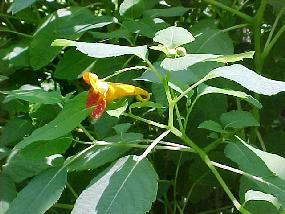 |
| Missouri Botanical Garden | | Jewelweed (Impatiens capensis) |
 |
- Scientific Name: Impatiens capensis
- Kingdom: Plantae - Plants
- Division: Magnoliophyta – Flowering plants
- Class: Magnoliopsida - Dicotyledons
- Family: Balsaminaceae – Touch–me-not family
- Genus: Impatiens L. – Touch-me-not
- Life Cycle: Annual
Description:
Jewelweed is a tall herb (0.5-2.5 meters high) with coarsely toothed leaves and clustered showy flowers. The leaves are oval, coarsely-toothed, bluish-green (to 3.5" long) that are glaucous or whitened on the underside. Dew or rain will bead up on the leaves forming sparkling droplets which gave rise to the common name of jewelweed.
Jewelweed has two kinds of flowers. The most obvious is the orange spotted flowers nodding from thin, threadlike stems. The showy flower consists of several petal-like sepals in the shape of a tube or trumpet with a spur at the end. The showy flowers are about an inch in length and are orange-yellow with mottled reddish brown spots on the inside of the trumpet. There is also a similar but different species that has yellow showy flowers (Impatiens pallida). The attractive flowers are said to resemble jewels.
The other flower is a tiny petalless flower that never opens. These tiny flowers produce most of the seeds, which when ripe, explosively split open at a touch, dispersing the tiny seeds several feet in all directions, hence receiving the common name of touch-me-not.
Habitat:
Jewelweed ranges throughout the United States with the exception of Wyoming, Montana, and the southwest including California. Jewelweed blooms from June to October and can be found throughout Shenandoah National Park along many of the trails that lead down into the valleys and hollows. Jewelweed is common near streams or in moist, shaded areas. Potential places where jewelweed may be located include: Nicholson Hollow Trail, Dark Hollow Falls, Jeremy’s Run, Rose River Trail, South River Falls Trail, Pass Mountain Trail, Gravel Spring Trail, and along with sections of the Appalachian Trail.
Other Facts:
Hummingbirds and butterflies are attracted to the showy flowers to collect nectar. There are currently no threats, insect or biological, that are affecting this species.
Jewelweed is commonly found growing near stinging nettle (it does sting) in the park. Native Americans used the watery plant juices to relieve itching and irritation associated with poison ivy, stinging nettle and insect bites. They have also been known to use jewelweed as an aid for dealing with dermatological, gastrointestinal, gynecological, pediatric, orthopedic, pulmonary, kidney, liver and urinary conditions. They also used jewelweed as an eye medicine, a diuretic, a burn dressing, and as a yellow/orange dye.
References and Links
Strausbaugh, P.D., Core, Earl L., Flora of West Virginia, Second Edition, Seneca Books Inc., Morgantown, West Virginia, p.622.
Further information about jewelweed can be found:
Integrated Taxonomic Information System (ITIS) Report U.S. Department of Agriculture
Germplasm Resource Information Network database which is sponsored by the Agricultural Research Service, U.S. Department of Agriculture.
PLANTS National Database, a website supported by the Natural Resource Conservation Service.
The University of Michigan – Dearborn, maintains an ethobotanical database that contains other interesting information on jewelweed.
Kempler Center for Home Gardening –Missouri Botanical Garden
Common Summer Wildflowers of West Virginia
Listing of these websites does not and is not intended to imply endorsement by the National Park Service of commercial services or products associated with the sites.
| 





